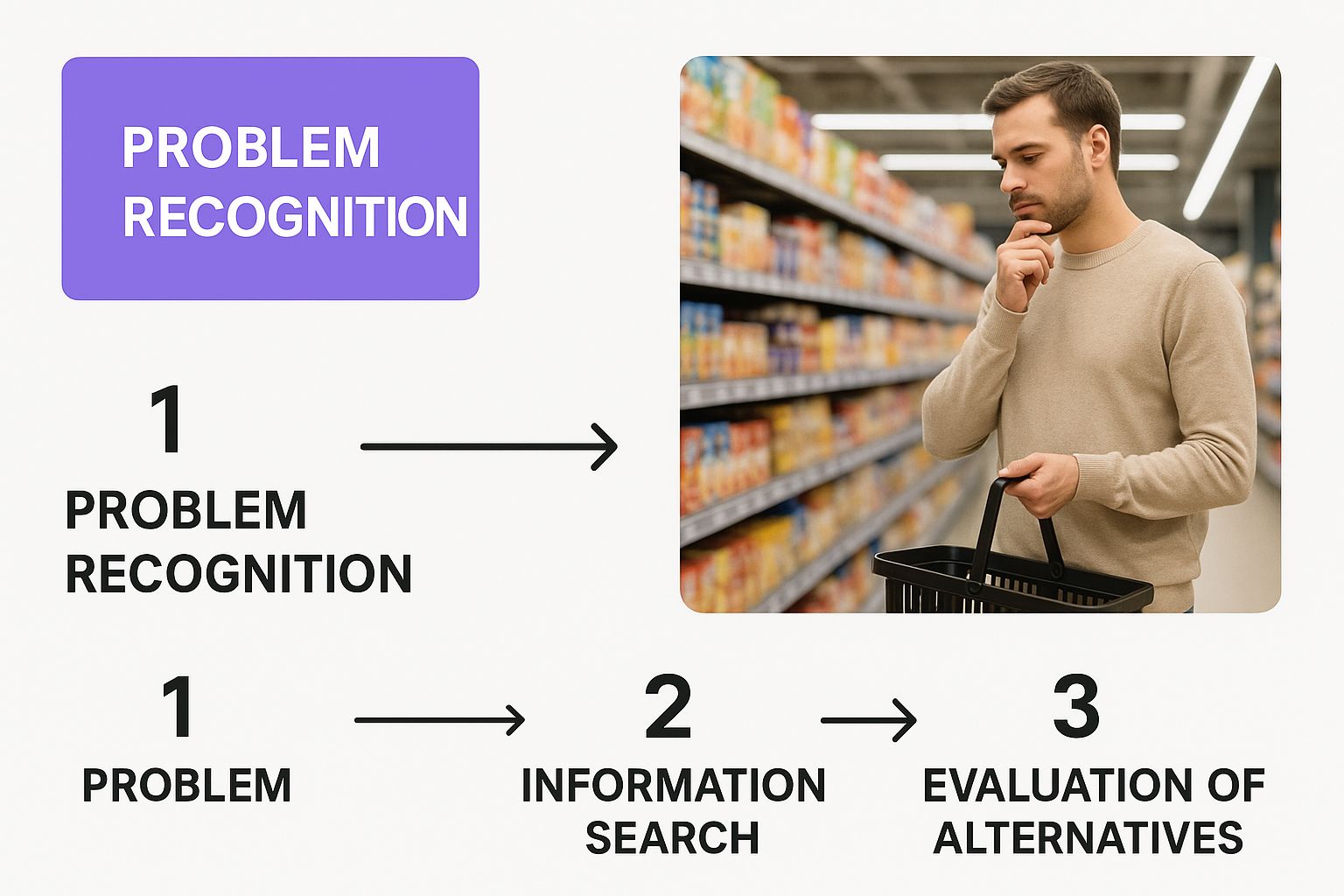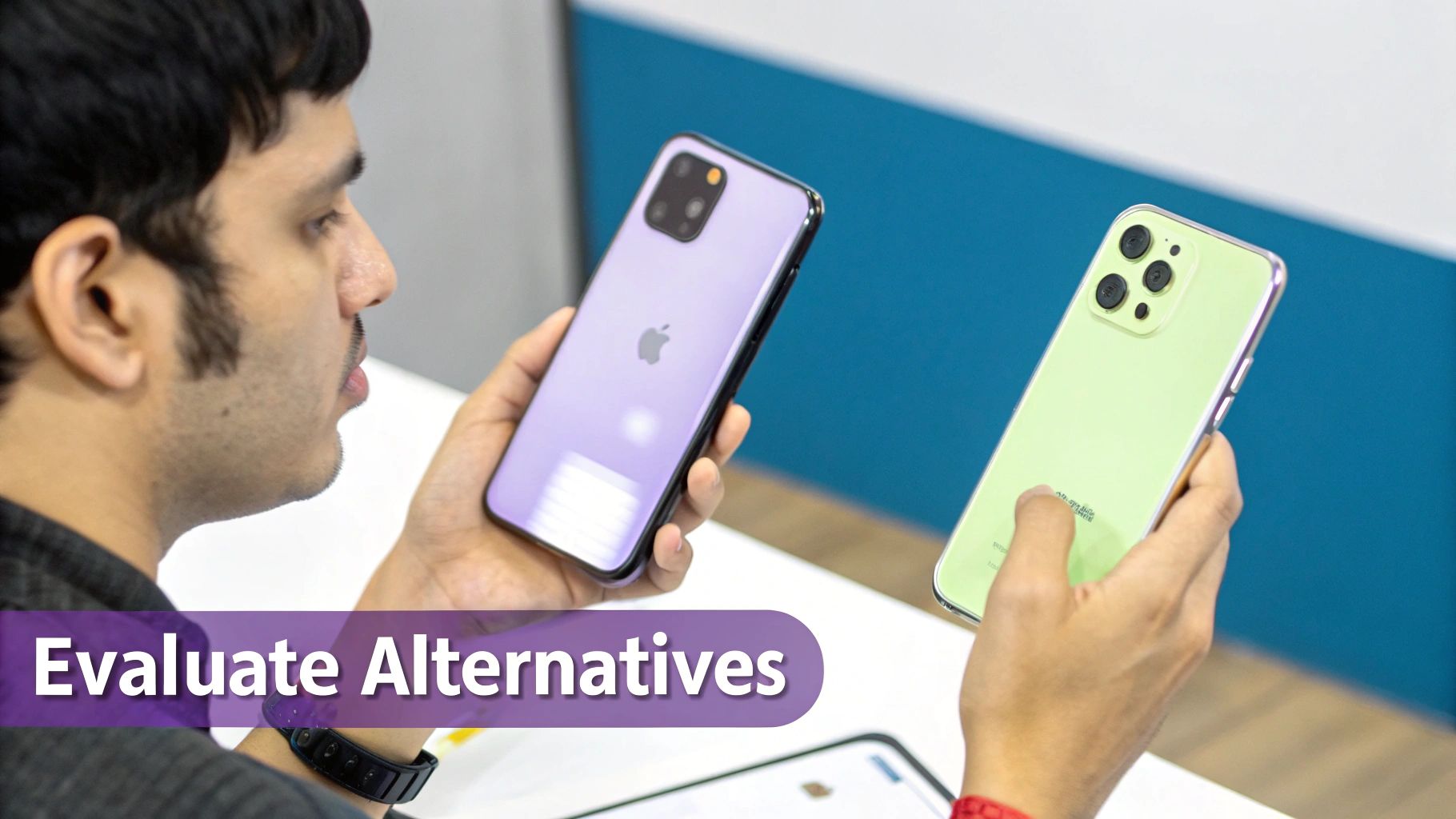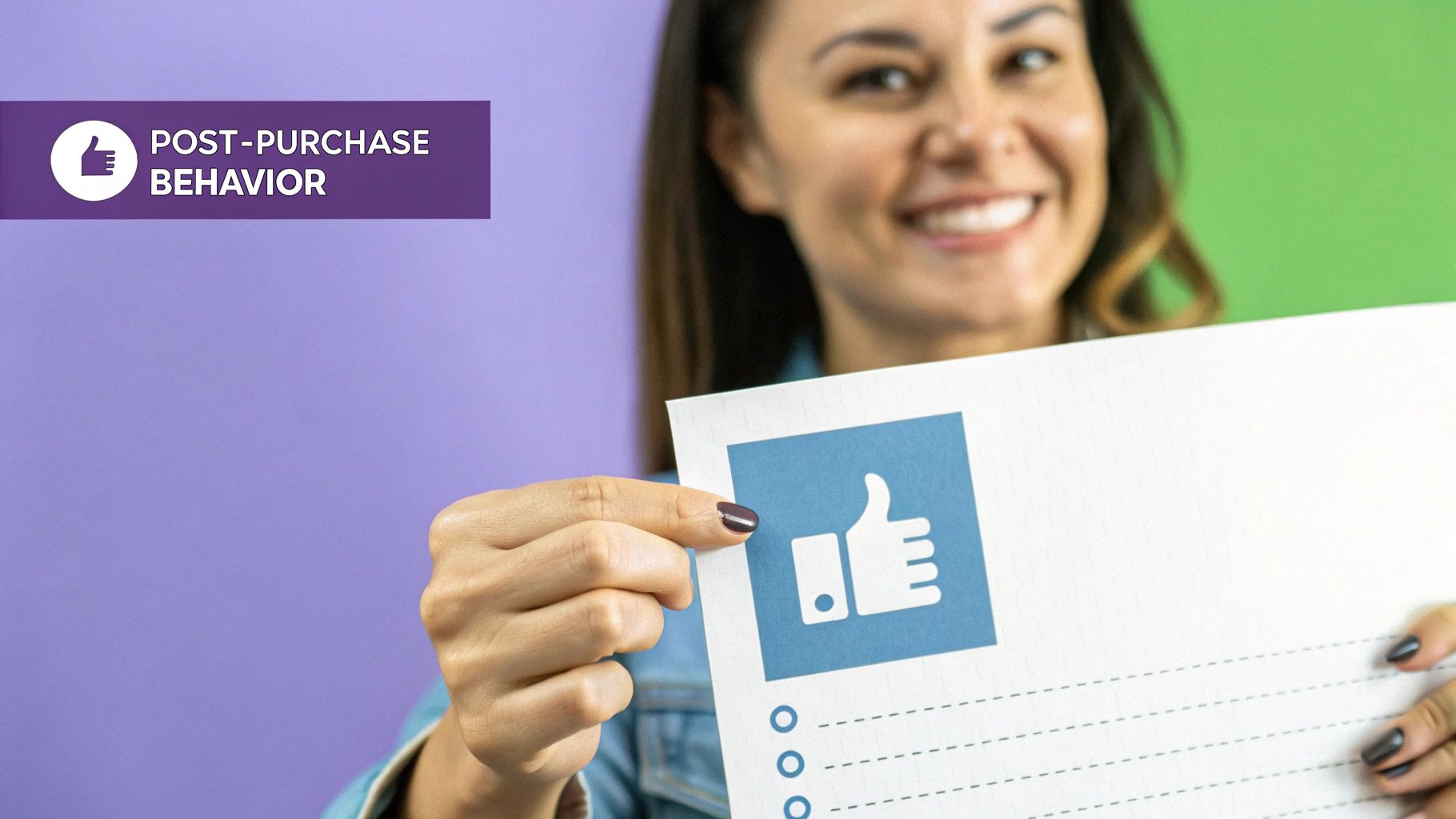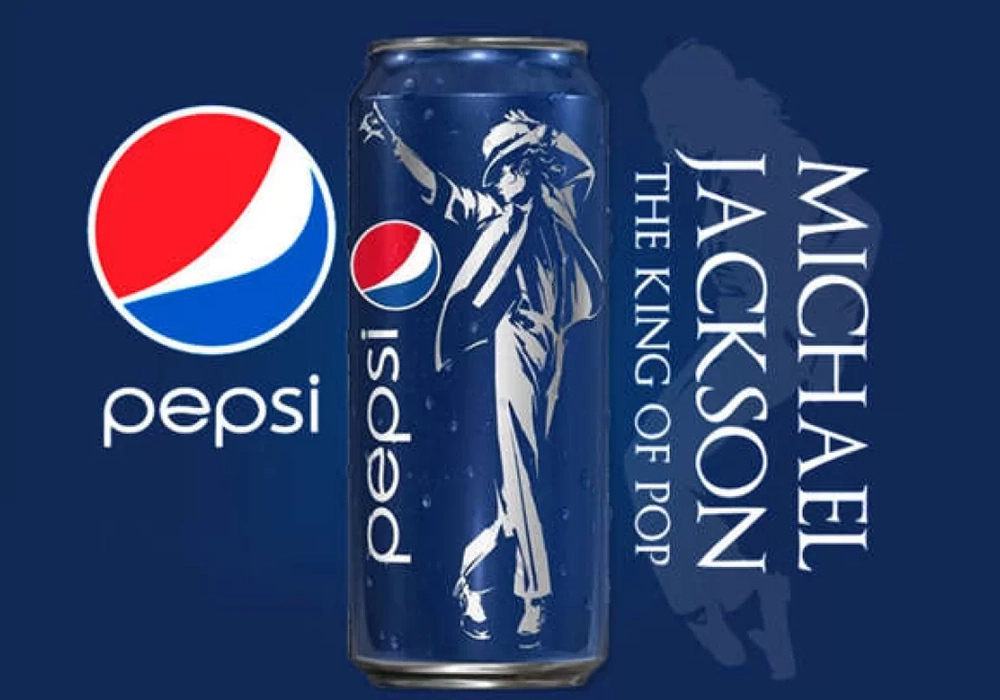Decoding Today’s Consumer Decision Process
The consumer decision process has evolved. It’s no longer a simple five-step journey. Instead of a straight line from recognizing a need to post-purchase behavior, consumers now move back and forth between stages. The digital world plays a huge role in this change, making it essential for businesses to understand how these decisions are really made.

This image demonstrates how even a simple trip to the grocery store involves problem recognition: realizing you need something. This realization kickstarts the entire consumer decision process, a process significantly impacted by digital marketing. Need help navigating this complex landscape? Check out this helpful guide on digital marketing strategies.
The Non-Linear Journey
This non-linear journey is primarily due to the wealth of information available online. Consumers can quickly switch between researching products, comparing prices, and looking for reviews. For instance, someone might realize they need a new laptop (problem recognition) and then immediately jump to reading online reviews (information search) before even thinking about specific brands. They might also revisit those reviews several times, even after buying the laptop.
This easy access to information is empowering for consumers, but it also creates challenges for businesses. Getting noticed amidst all the online content requires a more strategic approach. Marketers need to understand what drives this dynamic process.
Key Influences on Consumer Decisions
While the online world has reshaped the consumer decision process, the core drivers haven’t changed much. Quality, functionality, convenience, and price are still very important. But these factors are now linked to broader lifestyle considerations. Euromonitor International reports that consumers are increasingly looking for value for their money while also seeking products that align with their personal values, such as sustainability and wellness. Learn more about these evolving consumer trends.
Adapting to the Evolving Landscape
To thrive in this environment, businesses need to adjust their strategies to meet these changing demands. This includes:
- Creating personalized experiences: Tailoring marketing messages and offers to each consumer’s individual behavior.
- Building trust through transparency: Being upfront about product information and where materials come from.
- Providing seamless omnichannel experiences: Ensuring customers have a consistent brand experience across all platforms.
- Leveraging social proof: Sharing positive customer reviews and testimonials to build trust.
Understanding today’s consumer decision process is crucial. It’s no longer a nice-to-have, but a must-have for success. By recognizing the non-linear nature of the journey and adapting strategies accordingly, businesses can effectively connect with consumers, build strong relationships, and achieve their goals.
Triggering the Decision Journey: Beyond Problem Recognition
The consumer decision process isn’t always about customers recognizing a need. Sometimes, it starts long before that. Smart brands actively work to create these moments of awareness. This means understanding consumer psychology and developing natural, not forced, strategies. The goal? To activate latent needs – those desires consumers might not even know they have.
Understanding the Triggers
Activating latent needs starts with understanding consumer motivations. These triggers typically fit into three main categories:
Functional Triggers: These address practical needs and pain points. Imagine a software company subtly highlighting the flaws in a competitor’s product. This can prompt consumers to consider a better option.
Emotional Triggers: These tap into feelings and aspirations. Think about luxury car commercials. They often focus on the sense of freedom and prestige that comes with owning their vehicles.
Social Triggers: These use the influence of others. Testimonials and user-generated content can create a sense of community and the desire to belong.
By understanding these triggers, businesses can position their product as the perfect solution to a specific problem, even before the consumer actively searches for one.
Activating Needs Through Content and Messaging
Content strategy is essential for activating latent needs. Instead of a hard sell, focus on educating consumers about potential problems and their solutions. This could be through blog posts, social media updates, or even interactive quizzes.
For example, an ergonomic office furniture company might write a blog post about the impact of bad posture. This educates readers about a problem they might not have fully realized, positioning ergonomic furniture as the answer.
Targeted messaging refines this approach further. By segmenting audiences based on demographics, interests, and online behavior, brands can tailor their message to specific needs and pain points. This ensures the right message reaches the right person at the right time. Social proof, like customer reviews, further amplifies this effect.
Let’s explore the different types of consumer needs in more detail:
To understand this better, let’s look at a table summarizing the various types of consumer needs:
Types of Consumer Needs That Trigger Purchases
| Need Category | Description | Consumer Signals | Marketing Approaches |
|---|---|---|---|
| Functional | Addresses practical needs and solves problems | Complaints about existing solutions, seeking information on specific features, price comparisons | Highlight product features and benefits, demonstrate value proposition, offer competitive pricing |
| Emotional | Appeals to feelings, desires, and aspirations | Expressing desires or frustrations, seeking inspiration or validation, engaging with emotionally charged content | Craft compelling narratives, use aspirational imagery, build brand personality |
| Social | Driven by the influence of others and the desire to belong | Following trends, seeking recommendations, engaging with communities | Showcase testimonials and user-generated content, build online communities, leverage influencer marketing |
This table highlights how understanding different need categories allows businesses to tailor their marketing strategies for maximum impact. Addressing functional needs requires showcasing practicality, while emotional needs necessitate connecting with the consumer on a deeper level. Social needs are best met by fostering a sense of belonging and community.
Examples of Successful Need Activation
Many brands have effectively used these techniques. Consider a meal-kit delivery service. Instead of just advertising their meals, they might share quick and easy weeknight dinner recipes on social media. This subtly addresses the pain point of busy weeknights and positions their meal kits as the convenient solution.
This understated approach starts the consumer decision process without aggressive selling. By focusing on the consumer’s experience and offering valuable content, brands can naturally guide potential customers towards their products. This builds trust and brand loyalty, making the journey from awareness to purchase feel smooth and organic.
The Research Revolution: How Decision-Makers Evaluate Options

The way consumers research and evaluate products has changed drastically. Instant access to a wealth of information has redefined the decision-making journey, requiring businesses to adapt their strategies to stay competitive.
The Rise of Online Research
The internet is now the go-to resource for most consumers. Online platforms offer an immense amount of information, from product reviews and comparisons on sites like Amazon to expert opinions and social media discussions. This empowers consumers with more knowledge but creates a challenge for businesses vying for attention in the digital marketplace.
For example, consider someone researching a new camera. They might begin by searching “best cameras of 2024” online. This could lead them to reviews on tech websites like TechRadar, comparison videos on YouTube, and price checks on various e-commerce platforms. This multi-platform approach is now commonplace.
Social Validation and the Power of Reviews
Social validation is key. Consumer reviews are influential shortcuts, offering glimpses into real-world product experiences. Potential buyers often rely on these reviews to assess quality, reliability, and value.
Social media has also become central to product discussions. Consumers often seek advice within their networks, reinforcing the importance of social proof. This highlights the need for businesses to manage their online presence effectively and cultivate positive customer relationships. Building trust through authentic reviews and engagement on platforms like Facebook is crucial.
Filtering the Information Overload
The sheer volume of online information can be overwhelming. Consumers face a constant barrage of data, making it challenging to discern valuable insights and make informed decisions. Businesses need to present information clearly and concisely.
Furthermore, purchasing decisions are now influenced by more than just product features. Sustainability, for instance, is a growing concern. 58% of consumers are willing to pay more for sustainable products, showcasing a preference for eco-conscious brands. Discover more about consumer spending trends. This shift necessitates incorporating values-based messaging into marketing strategies.
Optimizing for the Research Phase
Reaching consumers during the research phase requires optimizing your digital presence. This involves several key actions:
- Investing in SEO: Ensure your website ranks highly in relevant search results.
- Creating high-quality content: Provide valuable information that addresses consumer needs and questions.
- Building a strong online reputation: Actively manage reviews and interact with customers on social media.
- Making information easily accessible: Design user-friendly websites with easy-to-navigate content.
- Highlighting trust signals: Showcase certifications and awards that demonstrate credibility.
By understanding the research process, businesses can position their brands effectively, build trust, and ultimately influence consumer choices. Providing relevant information in a user-friendly format empowers consumers to make decisions aligned with their needs and values.
Converting Intent to Action: The Purchase Decision Moment
This is the crucial moment for any business: the point where a potential customer decides to buy or walk away. It’s a pivotal opportunity, but also a potential pitfall. Understanding the psychology of this moment can be the difference between a sale and an abandoned shopping cart.
Decoding the Psychology of Purchase
Logic often takes a backseat at this stage. Emotions, social cues, and even the shopping environment itself can unexpectedly influence decisions. Imagine a customer diligently researching laptops, settling on one based on specs and reviews. Then, a friend mentions another brand, and a flashy in-store display catches their eye. Suddenly, their carefully considered choice is up in the air.
Social influence can create a powerful sense of urgency. “Limited-time offer” and “Only 3 left in stock!” messages tap into our fear of missing out (FOMO). This tactic is especially effective for items with high social visibility, like the latest fashion trends or tech gadgets.
Even the most eager buyer can be deterred by a difficult shopping experience. Long checkout lines, complicated payment processes, or unexpected shipping fees create purchase friction, often leading to abandoned carts.
Reducing Friction and Addressing Objections
Minimizing these friction points is key. A smooth, enjoyable buying experience is essential. Here’s how to achieve it:
- Streamlined checkout: Offer guest checkout, securely save payment information, and keep forms short and sweet.
- Transparent pricing: Show all costs upfront, including taxes and shipping. No surprises!
- Multiple payment options: Accept a range of credit cards, digital wallets like Apple Pay, and even financing.
- Responsive customer service: Easy access to support for last-minute questions or concerns is vital.
Proactively addressing potential objections is another crucial step. Anticipate common questions about price, features, or warranties. Provide clear answers in FAQs or product descriptions. Live chat support adds a personal touch, offering reassurance and building trust.
Pricing Psychology and Authentic Urgency
Pricing psychology significantly influences purchase decisions. “Charm pricing” (.99 endings) creates a perception of value. Bundling products or offering bulk discounts can also encourage larger purchases.
Creating authentic urgency without resorting to manipulative tactics is key. Highlighting genuinely limited-time offers or exclusive deals motivates action without eroding trust. Emphasizing immediate benefits, like free shipping or bonus gifts, adds to the appeal.
Let’s take a closer look at the key factors that can sway a purchase decision with the table below:
To help understand this crucial moment in more detail, we’ve compiled the following table:
Key Factors Influencing Final Purchase Decisions: A comprehensive breakdown of the various elements that impact consumer purchase decisions at the moment of truth, with data on their relative importance across different product categories.
| Decision Factor | Impact Level | Category Variations | Optimization Strategies |
|---|---|---|---|
| Price | High | Sensitivity varies (luxury vs. necessity) | Competitive pricing, discounts, value bundles |
| Social Proof | Medium | Stronger for trends and social products | Reviews, testimonials, influencer marketing |
| Urgency | Medium | Effective for limited-time offers | Authentic scarcity, deadline reminders |
| Purchase Friction | High | Impacts all categories | Streamlined checkout, easy returns |
| Customer Service | Medium | Important for complex or high-value purchases | Live chat, readily available support |
As you can see, several factors combine to influence the final purchase decision. Understanding these factors allows you to tailor your approach to different product categories and customer needs.
From Consideration to Commitment
The final purchase is a transition from considering a product to committing to it. By understanding the psychology of this moment, businesses can optimize the buying process, reduce cart abandonment, and drive conversions. This means leveraging pricing psychology, creating authentic urgency, minimizing friction, and addressing concerns head-on. Successfully navigating this stage creates momentum, carrying the customer into the next phase: the post-purchase experience.
Beyond the Purchase: Building Decision Process Loyalty

The consumer decision process doesn’t end at the checkout. This crucial post-purchase phase offers significant opportunities for business growth, turning one-time buyers into loyal customers.
Managing Post-Purchase Dissonance
After making a purchase, consumers sometimes experience buyer’s remorse, that unsettling feeling of doubt or regret. This is particularly common with big-ticket items or when choosing from several appealing options. Managing this dissonance is essential for building lasting customer relationships.
Strategic follow-up communication is key. A simple thank-you email reinforcing the value of their purchase can make a real difference. Personalized product recommendations based on their purchase history also show you understand their needs.
Creating Emotional Connection
Post-purchase interactions shouldn’t just validate the transaction; they should forge an emotional bond with the customer. Think about the difference between a generic order confirmation and a personalized message expressing enthusiasm for their new item.
Building a sense of community around your brand further strengthens this connection. Exclusive online forums, active social media groups, or even in-person events can cultivate a sense of belonging. This transforms the brand from simply a product provider to a shared experience.
Loyalty Programs That Truly Engage
Many loyalty programs simply reward transactions. Truly effective programs, however, influence behavior. They offer unique perks, early access to new products, or opportunities for deeper brand engagement.
For example, a coffee shop’s loyalty program could offer a free drink after a certain number of purchases. A more engaging program might also offer exclusive brewing workshops or early access to limited-edition roasts.
Triggering the Next Decision Journey
The ultimate goal of the post-purchase experience is to seamlessly initiate the next purchase. This can be done by offering helpful content related to the initial purchase, suggesting complementary products, or offering tailored recommendations.
For example, a company selling gardening tools might send emails with timely gardening tips, naturally prompting customers to consider new tools for upcoming projects. This keeps the brand top-of-mind and nurtures the customer relationship. Furthermore, customer satisfaction significantly impacts repeat purchases. Improving from a one or two-star experience to three stars can boost repeat business by as much as 68%. More detailed statistics can be found here. This highlights the importance of positive post-purchase interactions.
Building a Foundation for Long-Term Growth
By prioritizing post-purchase engagement, businesses cultivate loyalty, boost repeat sales, and transform satisfied customers into brand advocates. This builds a solid foundation for sustained growth in any competitive market. It’s about more than just acquiring customers; it’s about nurturing a loyal community that consistently chooses your brand.
Digital Disruption of the Consumer Decision Process
The consumer decision process has changed. What was once a predictable series of steps is now a dynamic journey, heavily influenced by the digital world. New technologies aren’t just changing the journey; they’re creating entirely new paths to purchase.
AI-Powered Personalization
Those “recommended for you” sections online? They’re powered by AI-driven recommendation engines. These engines analyze your browsing, past purchases, and even social media activity to predict what you might want. This personalized approach simplifies the search and evaluation process, presenting options tailored to individual preferences.
This kind of personalization helps consumers quickly find what they need, making the buying process more efficient. Businesses that utilize these engines often see increased customer engagement and sales conversions.
The Rise of Voice Search
Voice search, through tools like Siri or Alexa, is transforming how we search. Instead of typing keywords, we ask questions conversationally. This leads to more specific search results. Businesses need to adapt their content to these conversational queries. For example, think about targeting “What are the best running shoes for marathon training?” instead of just “best running shoes.”
This shift towards conversational queries requires a more nuanced approach to SEO (Search Engine Optimization). Businesses must anticipate the questions customers are asking and optimize their content accordingly.
Social Commerce and Influencer Marketing
Social commerce lets you shop directly within social media platforms. Imagine seeing a product you like on Instagram and buying it right there in the app. This blurs the lines between discovery, research, and purchase. Influencer marketing plays a key role here. Trusted influencers can directly affect purchase decisions within these social ecosystems.
This integration of shopping and social media significantly speeds up the consumer decision process. Influencers can provide valuable social proof, driving sales and brand engagement.
Immersive Experiences: AR and VR
Augmented reality (AR) and virtual reality (VR) offer immersive product interactions. Imagine virtually trying on clothes with AR or experiencing a travel destination in VR before booking. These technologies enrich the evaluation process, offering a deeper understanding of a product or service.
These immersive experiences provide valuable information to the consumer, helping them make more informed decisions. They can increase customer confidence and reduce purchase hesitation.
Navigating the Fragmented Journey
Consumers switch between multiple channels and devices, fragmenting the decision journey. An omnichannel strategy is crucial for maintaining brand presence. This means creating consistent, integrated experiences across all touchpoints, from websites to social media to in-store interactions.
A unified approach ensures a seamless experience, regardless of how a customer interacts with your brand. Each channel should work in concert to guide the customer toward a purchase.
The Future of Consumer Decisions
Emerging technologies will continue to reshape the consumer decision process. The growth of the metaverse will bring new immersive shopping experiences. AI will become even more advanced, anticipating needs before consumers even recognize them.
Businesses must remain adaptable and embrace these changes to stay competitive. Understanding the digitally disrupted consumer journey isn’t just about keeping up; it’s about understanding your customer and meeting their evolving needs. By recognizing how technology influences their choices, you can craft more effective strategies to connect with them at every step.
Want to stay ahead and understand the ever-changing consumer? Notifyio provides expert insights and strategies for mastering digital marketing. Visit Notifyio today to learn more.




Leave a Reply